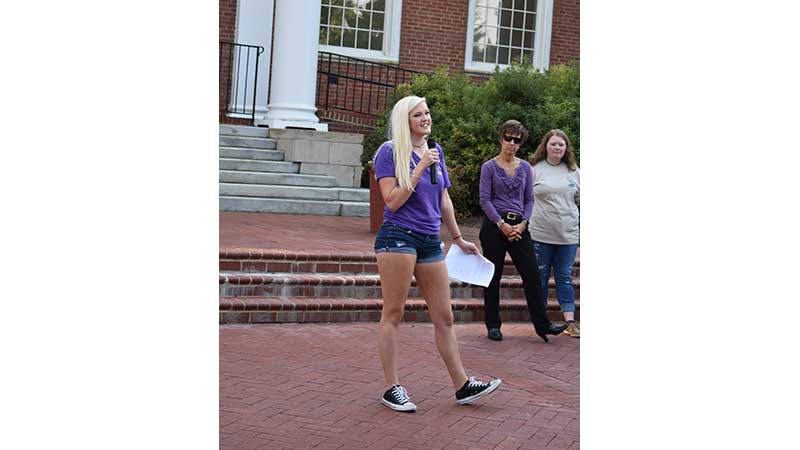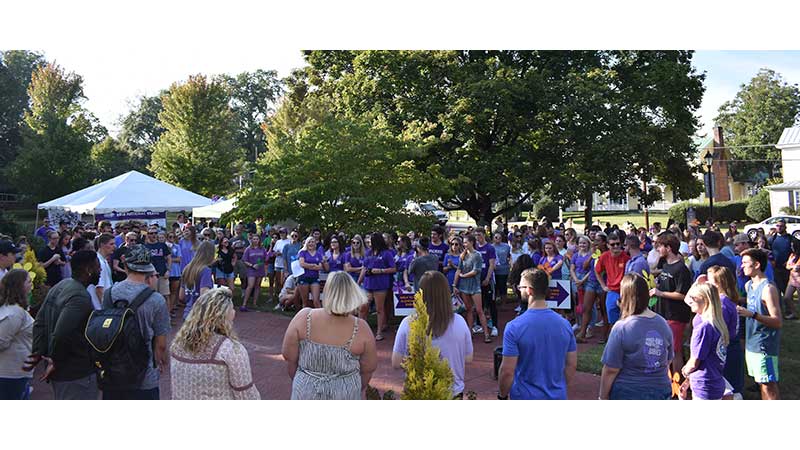Walking for Alzheimer’s research
Published 11:37 am Thursday, October 11, 2018
Longwood University students and members of the community walked around campus, holding plastic flowers and wearing purple shirts to voice support of research and a cure for Alzheimer’s disease.
The annual Walk to End Alzheimer’s on campus took place Thursday.
(To view a small gallery of photos from the event, click here.)
Participants began on High Street, turning left onto Griffin Boulevard and then looping back onto the university campus before rejoining outside Lancaster Hall.
The Sigma Kappa Sorority organized the walk, which benefited the Alzheimer’s Association, an organization that funds research and a cure for Alzheimer’s disease.
Alzheimer’s, a brain disease and a common form of dementia, causes memory loss, and loss of other mental and eventual physical functions.
Jennifer Chavez, development manager with the southeastern chapter of the Alzheimer’s Association, said the Farmville walk is typically well-supported by students.
“The walk is always well-attended by students of Longwood,” Chavez said.
The chapter is seeking to reach a goal of $19,800 for the year. The chapter is currently at $16,017.
The Woodland Inc. in Farmville raised approximately $2,650.
The chapter covers 16 counties and 7,400 square miles, including Prince Edward.
Signs of Alzheimer’s disease, according to the Alzheimer’s Association website, include memory loss that disrupts daily life, difficulty completing familiar tasks at home or work, confusion with time or place, new problems with speaking or writing, withdrawal from work or social events and changes in mood and personality that include confusion, suspicion, depression, fear, anxiety or becoming easily upset when out of a familiar setting.
During the event, members of Kappa Sigma read statistics relating to the disease that included in the United States, that someone is diagnosed with Alzheimer’s every 65 seconds; that 5.7 million Americans live with Alzheimer’s, this number could increase to nearly 14 million by 2050; the disease serves as the sixth leading cause of death, causing more to die than breast and prostate cancer combined; the average cost of care for someone living with dementia is estimated to be $341,840, and the national cost of care for those with dementia is estimated to be $277 billion.
Student and Kappa Sigma member Julia Byrd, who led the walk, spoke about her passion for supporting those with Alzheimer’s. She said there’s a misconception that Alzheimer’s disease is only characterized by forgetting things. She said the symptoms extend beyond that.
“I would hear residents who would think someone was chasing them, even though no one was around,” Byrd said. “Some residents would finish their meal, then say we didn’t feed them seconds after eating. Some residents would try to convince them that they were 35 years old. When visitors would come to see their parents, they would leave defeated. I would ask them ‘how is Mom doing?’ and they respond, ‘that’s not my mom anymore.’”
She spoke about interacting with a man named Tom who she worked with at a memory care center. After asking Tom for life advice, he told her: “Let everyone live their own life, and live it the best that they can.”
“Today, I am walking for my residents,” Byrd said about those at the memory care center. “For Hazel, and Tom, for Dorothy and Harry, and for their families who miss them already.”
John Horoszewski with Edward Jones Investments, the national presenting sponsor for the Walk to End Alzheimer’s, spoke about how approximately 40 percent of their clients are on average 65 years or older, and seeing firsthand how Alzheimer’s causes clients to not only lose wealth but lose themselves.
“It damages relationships with friends and family,” Horoszewski said. “And in many cases it destroys finances for both the individual facing the disease and her or his family.”
“We, like the Alzheimer’s Association, won’t rest until the world is rid of Alzheimer’s,” Horoszewski said.







